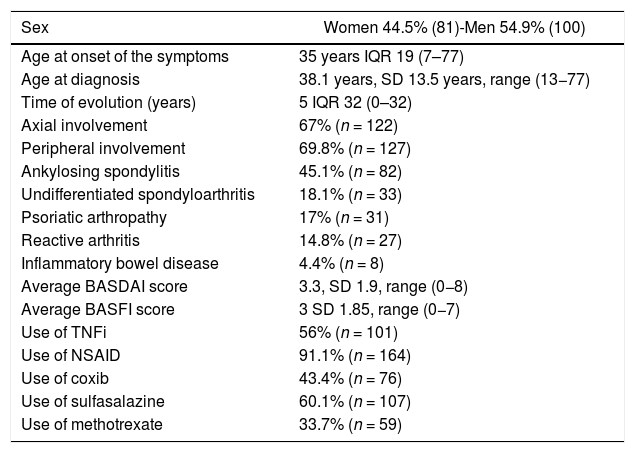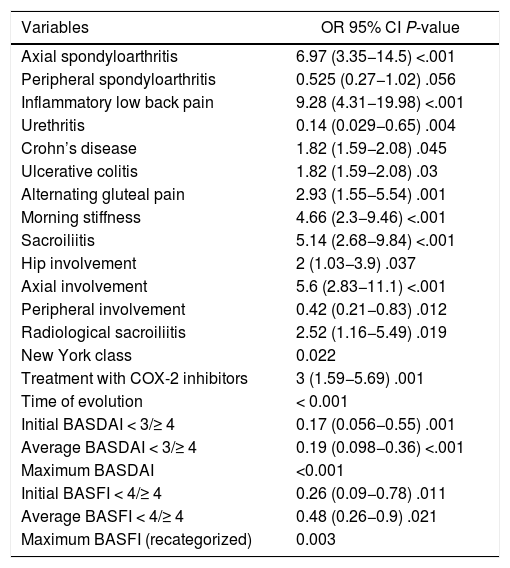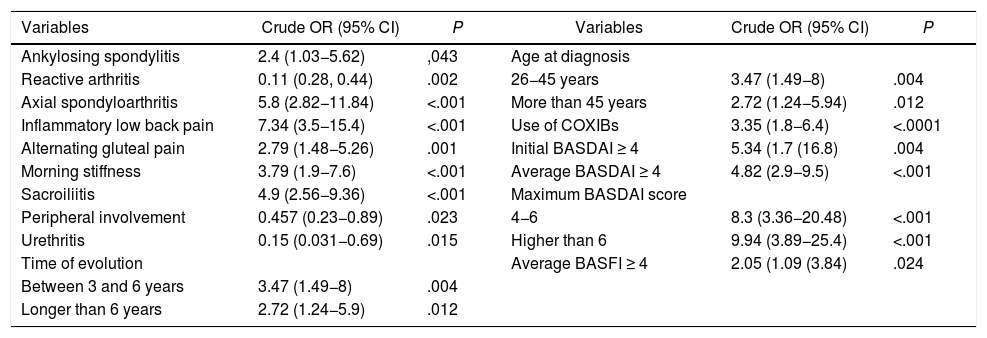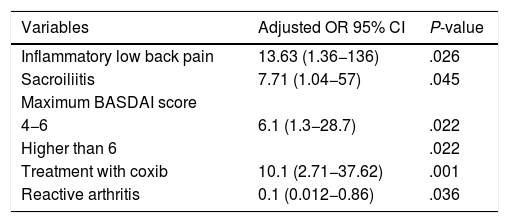The use of tumor necrosis factor (TNF) alpha inhibitors is increasing in patients with spondyloarthritis. Early identification of those that would require them, or the ability to predict their use, could lead to a more effective and timely treatment by rationalizing their use.
ObjectiveTo determine factors that better explain the indication of TNFi in the study population.
Material and methodsThe association between anti-TNFα use and categorical demographic, clinical, laboratory, radiological and treatment variables was explored using Pearson's Chi2 or Fisher's exact test. The association with the quantitative variables was evaluated using Student's t test or Mann Whitney U test, depending on their distribution. Those variables with P < .25 were entered into univariate models of explanatory logistic regression to construct crude ORs, and those with P < .25 were included in the multivariate model to construct adjusted ORs.
Results and discussionThe study population includes 181 patients. In the univariate model: reactive arthritis, urethritis, and peripheral involvement were protective factors for the use of TNFi. Axial spondyloarthritis, inflammatory lumbalgia, alternating gluteal pain, morning stiffness, sacroiliitis demonstrated by any method, treatment with COX2 inhibitors, evolution time of three years or more, and BASDAI and BASFI scores were associated with the use of TNFi. Multivariate model: reactive arthritis (P = .036), inflammatory back pain (P = .026), sacroiliitis (P = .045), use of coxibs (P = .001) and the maximum score of BASDAI (P = .022, P = 006) were independently associated with the use of TNFi. The use of coxibs was associated with the indication of using TNFi in both patients with axial (P = .001) and peripheral spondyloarthritis (P < .001).
ConclusionsThe onset of the disease in the form of reactive arthritis behaved as a protective factor for the subsequent need to use TNFi, while presenting with inflammatory back pain, sacroiliitis, demonstrated by any method, treatment with coxibs, and the maximum score of BASDAI greater than 4 associated with the use of these medications.
El uso de TNFi es cada vez más frecuente en los pacientes con espondiloartritis. Identificar tempranamente aquellos que los requerirán o poder predecir su uso puede ayudar a hacer un tratamiento más efectivo y oportuno racionalizando su uso.
ObjetivoDeterminar los factores que mejor explican la indicación de TNFi en la población de estudio.
Material y métodosLa asociación entre el uso de medicamentos anti-TNFα y las variables categóricas demográficas, clínicas, de laboratorio, radiológicas y de tratamiento se exploró por prueba exacta de Fisher. La asociación con las variables cuantitativas fue evaluada con T de Student o U de Mann Withney de acuerdo a su distribución. Aquellas variables con P < .25 fueron ingresadas a modelos univariante de regresión logística explicativa para construir los OR crudos y aquellas con P < .25 se incluyeron en el modelo multivariante para construir OR ajustados.
Resultados y discusiónLa población está constituida por 181 pacientes. Modelo univariante: la artritis reactiva, uretritis y compromiso periférico fueron factores protectores para el uso de TNFi. Espondiloartritis axial, lumbalgia inflamatoria, dolor glúteo alternante, rigidez matinal, sacroilitis demostrada por cualquier método, tratamiento con inhibidores COX2, tiempo de evolución de tres años o más y los puntajes de BASDAI y BASFI se asociaron al uso de TNFi. Modelo multivariante: artritis reactiva (OR 0.1, IC95% 0.012–0.86, P = .036), lumbalgia inflamatoria (OR 13.63, IC95% 1.36–136, P = .026), sacroilitis (OR 7,71, IC95% 1.04–57, P = .045, uso de coxibs (OR 10.1, IC95% 2.71–37.62, P = .001) y el puntaje máximo de BASDAI (4–6: OR 6.1, IC95% 1.3–28.7, P = .022, mayor de 6: OR 15.8, IC95% 2.2–113, P = .006) se asociaron independientemente con el uso de TNFi. El uso de coxibs se asoció a la indicación de usar TNFi tanto en los pacientes con espondiloartritis axial (OR 4.2, IC95% 1.74–10.11, P = .001 como periférica (OR 4, IC95% 1.85–8.62, P < .001).
ConclusionesEl inicio de la enfermedad en la forma de artritis reactiva se comportó como un factor protector para la necesidad posterior de usar TNFi mientras que presentar lumbalgia inflamatoria, sacroilitis demostrada por cualquier método, el tratamiento con coxibs y el puntaje máximo de BASDAI mayor de 4 se asociaron al uso de estos medicamentos.









